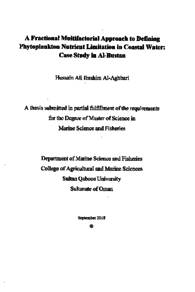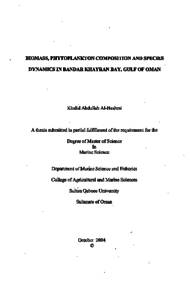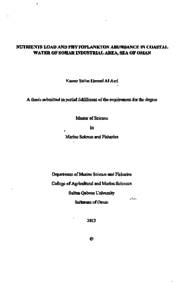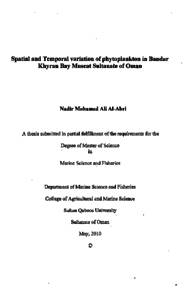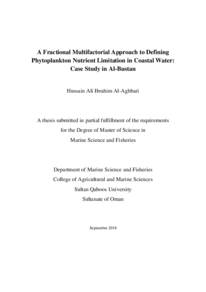Document
A fractional multifactorial approach to defining phytoplankton nutrient limitation in coastal water : case study in al-bustan
Publisher
Sultan Qaboos University
Gregorian
2018
Language
English
Subject
English abstract
High biomass phytoplankton blooms are recurrent in the Sea of Oman; some of these blooms can be harmful for marine life as well as for human health. Eutrophication has been suggested as one of the factors involved in promoting these blooms through inputs of nitrogen and phosphorous. In some oceanic areas described as "high-nutrient-low-chlorophyll", iron and other micronutrients may also be limiting phytoplankton growth. More recently, large areas of the world ocean were showing deficiency of B vitamins. This suggests that vitamin limitation could control phytoplankton production in coastal and open ocean environments. The aim of this work was to investigate experimentally the limiting nutrient(s) for natural phytoplankton community growth in the coastal waters of the Sea of Oman particularly in Al Bustan area (Muscat) during two different durations, spring bloom and post spring bloom. The factorial and fractional factorial designs were employed to test the role of inorganic nutrients, trace metals and vitamins in 500 ml of pre-filtered (180 um) seawater incubated under natural light (sunlight) for 48 hours. Phytoplankton response was evaluated by the measurement of in vivo chlorophyll-a. Results showed different limiting nutrients during the spring and after spring blooms. Nitrogen appeared to be the most significant factor after the spring bloom, whereas metals and vitamins were significant during the spring bloom. Phytoplankton development was driven by different compositions of nutrients. Results support the hypothesis that at some time throughout the year (during the spring), although basic nutrients (N, P, Si) are abundant, HABs species are not promoted easily because other nutrients are limiting. Before the spring bloom phytoplankton were limited by B12 or Cobalt and since most HAB species are auxotrophs for B12 (cannot synthesize de novo); HABs are thus unusual although nutrients concentrations may be high. After the spring bloom, the bacteria degraded the organic matter produced and provided a pool of B12, auxotrophic HAB species can grow and get nutrients below the thermocline (mobile species), although nutrients concentrations may be low. The fractional factorial design allowed the experimental identification of all 7 interacted nutrients alone or in pairs, using only 32 individual bottles. This study elaborated the need to conduct further investigations to assess the importance of vitamin B12 and its relation with cobalt as a growth factor for phytoplankton specially HABS
Description
Thesis
Member of
Resource URL
Arabic abstract
تتكاثر العوالق النباتية في بحر عمان بشكل دوري، وقد يكون ازدهارها في بعض الحالات ضارة للحياة البحرية وكذلك لصحة الإنسان. حيث يعزى ازدهار العوالق النباتية الى المغذيات كواحد من العوامل المحفزة للنمو من خلال مدخلات النيتروجين والفوسفور. في بعض المحيطات التي توصف بأنها "عالية المغذيات منخفضة الكلوروفيل"، وقد يحد الحديد والمغذيات الحقيقة الأخرى أيضا نمو العوالق. في الآونة الأخيرة ، تم تحديد مناطق كبيرة من محيطات العالم بأنها تعاني من نقص فيتامينات ب ، وهذا يشير إلى أن النقص في فيتامين (ب) يمكن أن يتحكم في نمو العوالق النباتية في المياه الساحلية أو المحيطات المفتوحة كان الهدف من هذا العمل هو إجراء دراسة تجريبية على المغذيات المقيدة لنمو العوالق النباتية في المياه الساحلية لبحر عمان تحديدا منطقة البستان في محافظة مسقط في فترتين مختلفتين، الربيع والفترة مابعد الربيع. تم استخدام التصاميم التحليلية التجريبية والجزيئية لاختبار دور كلا من المغذيات غير العضوية ، والمعادن الدقيقة والفيتامينات في عينات ذات سعة 500 مل من مياه البحر والتي تم ترشيحها عبر شبكة العوالق النباتية ذات فتحات لا تتجاوز ال (180 ميكرون) ووضع هذه العينات داخل أحواض مملوءة بالماء تحت عمق نصف متر واستخدام الضوء الشمس الطبيعي واحتضان هذه العينات لمدة 48 ساعة. بعد ذلك تم تقييم نمو واستجابة العوالق النباتية من خلال قياس الكلوروفيل في المختبر من خلال جهاز مقياس الكلوروفيل. حيث أظهرت النتائج أنه في الفترة ما بعد فصل الربيع يكون النيتروجين هو المغذي الرئيسي المحدد لإزدهار العوالق النباتية، في حين كانت المعادن الدقيقة والفيتامينات مقيدة النمو العوالق النباتية في فصل الربيع. وقد أظهر الإثراء التجريبي للمغذيات نتائج هامة شملت: (1) كانت استجابة الطحالب لإضافة المغذيات مؤشرا جيدا على المغذيات المتاحة كعامل محد؛ (2) أن استخدام مجموعة من العوالق النباتية المختارة والمتوفرة طبيعيا والتي لايتجاور حجمها ( 180 ميكرون) والبيئة الحاضنة شبه الطبيعية لدراسة الاستجابة كان مرتبطا مباشرة بالنتائج المتغيرة طوال مدة التجربة ؛ (3) عزز التصميم الجزيئي للتجربة كفاءة وفعالية في استخدام جميع فحوصات المغذيات لقياس ومعرفة التأثيرات من إضافة المغذيات لتحسين الدقة ؛ (4) أعطى التصميم الجزيئي أيضا إيضاحا لتأثير المغذيات المتفاعلة وسمح لنا بتقييم هذا التفاعل (5) ساعدنا التصميم الجزيئي في الحصول على مجموعة عدد كافية من العينات لفحص تأثير المغذيات عليها سواءا كانت هذه التأثيرات احادية ام ثنائية ام ثلاثية. (7) تم نمذجة المغذيات ذات التأثير المحدد لنمو العوالق النباتية على نموذج.
Category
Theses and Dissertations

